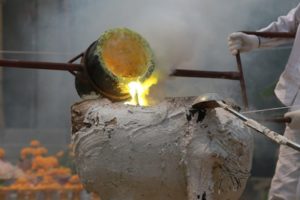What is the Titanium Investment Casting Process?

In the grand scheme of the industrial revolution, the titanium investment casting process might be considered a relatively new manufacturing method.
The process of investment casting itself, however, is hardly a recent development. In fact, the Lost Wax Method – as it is also known – has been in use and continually improved upon for more than 5,000 years! During the early eras, investment casting molds were produced by carving beeswax into intricate sculptures, which were then converted to bronze or copper using the investment casting process.
Although the process has evolved over centuries, core elements of the investment casting process have remained largely unchanged. Over the past several decades, however, some aspects – including “artificial” atmosphere control – have been refined so as to enable the previously impractical titanium investment casting process.
The process has been refined and fine-tuned over the ensuing centuries. As part of its rapid expansion into the titanium aerospace castings market, FS Precision has driven the process to the highest quality and control standards. At FS Precision, six sigma process control and continuous improvement are present in every aspect of our planning and manufacturing processes.
Wax Patterns for Investment Casting
The beginning stage of the investment casting process involves first creating a wax model – or “pattern” – of the product which captures all of a component’s design complexity and intricacies. At FS Precision, we produce this pattern through injection molding. Injection molding provides a stable and repeatable pattern production process, contributing to a highly efficient titanium investment casting process line.
In addition to injection molding, FS Precision has the capability to CNC machine or 3D print wax patterns. This enables us to support the cost constraints for some of our customers’ low volume programs where tooling costs might not be economically viable.

Ceramic Mold
Following production of patterns, the next stage of the titanium investment casting process is to combine several of those patterns into what is called a “tree” – using a technique known as water welding – so that multiple castings can be produced at the same time. Water welding is illustrated in our investment casting video. The tree is then dipped into a vat of viscous ceramic slurry mixture. This slurry later solidifies, creating a solid outer shell that will be ultimately be used as the mold vessel for the casting process.
After dipping and drying, the tree is then inserted into a high temperature furnace so that the wax patterns can be melted and drained from the mold shell. What remains is an empty tree carrying several molds of the final design for the titanium investment casting to be produced.
Molten Titanium
Following a few more steps, the tree is inserted into our Vacuum Arc Remelting (VAR) furnace, where an electric arc is used to melt a titanium alloy electrode. As it is melted, the molten titanium is collected in a crucible positioned above the mold tree. Once the titanium is completely melted, the crucible is tipped, allowing the molten titanium to flow downward into the mold tree. You can learn more about these steps from our article and video explaining the titanium casting process.
Post Casting Processes
After the molten titanium is poured, it is allowed to cool and solidify. Once solid, there is no longer any need for the ceramic mold, which is therefore destroyed to enable removal of the finished casting. This yields a tree of nearly completed titanium investment castings. Each of those castings being a virtual exact copy of the original wax pattern. All that remains are the final post cast processing operations, depending on the customer’s specifications.
Many of the post casting processes and inspections are defined by AMS and/or ASTM standards. The applicability for these different sets of specifications is typically dependent on the titanium investment casting end use application. Whether we are producing titanium aerospace castings or castings for subsea, chemical, or general industrial applications; FS Precision has extensive experience producing in accordance with these and other specifications.
The entire titanium investment casting process at FS Precision yields a cost-effective and repeatable procedure to deliver titanium’s remarkable properties to our customers.
If you’d like to explore how we can assist you with your needs for titanium investment castings, please click on the button below and send us your project details. In most cases we can respond within 1-2 business days with an estimate of cost and lead time to assist you in your program development process. FS Precision is different from all of the others in the industry, because we go out of our way early in your process to help you and your development team to create an optimum solution.
FS Precision is an emerging global leader for structural investment castings for fixed wing, rotary wing, space launch, and aerospace systems. Our AS9100 certified investment casting foundries are located in the USA and Taiwan. Our USA factories are FFL registered, and our Taiwan facilities actively support the fulfillment of customer offset obligations to Taiwan.

